Chocolate Namelaka is one of the most delicious creams that is a must in your baking repertoire to fill, frost, or beautifully decorate your desserts! This silky, delicious cream is very well balanced in sweetness, has the most perfect pipeable texture, and comes together really easily and quickly with basic everyday ingredients such as milk, chocolate (either white, milk, or dark), heavy cream, and gelatin.
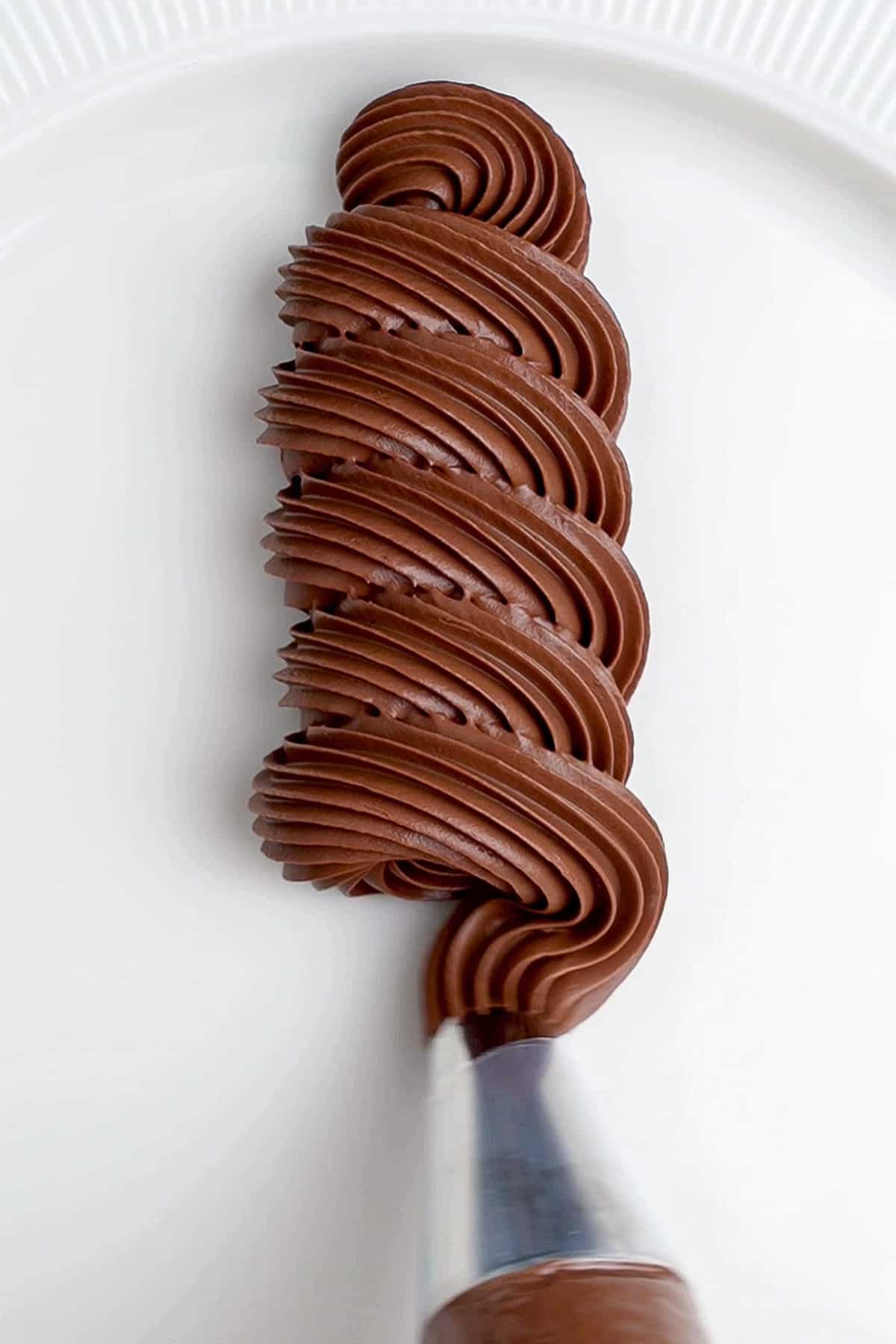
Jump to:
💡 What is namelaka
Namelaka was invented by the world-famous Chocolate company, Valrhona, and has become more and more popular in recent years even outside of the pastry chefs' world.
The term namelaka comes from Japan literally meaning smooth and creamy and this dark chocolate namelaka recipe perfectly delivers on the promise of being smooth and creamy! The texture of the cream is the perfect cross between ganache, pastry cream, and mousse. It is rich just like chocolate ganache, silky that might remind you of pastry cream, yet more delicate and lighter, so kind of similar to mousse.
What does namelaka taste like? It depends on what chocolate you use! This cream can be made using all kinds of chocolate eg. you can make milk chocolate namelaka, white chocolate namelaka, or dark chocolate namelaka like this recipe. Either way, make sure to use high-quality chocolate as the flavor will be as delicious as the chocolate. Please note that the milk component can also be flavored eg. infused with orange zest or cinnamon, which will bring additional flavors to your namelaka.
🍫 Difference between namelaka and chocolate ganache
Both namelaka and chocolate ganache can be used to fill, frost, or decorate desserts. They both contain chocolate and cream, however, namelaka also contains milk and gelatin making its texture lighter compared to ganache.
The preparation process is also slightly different. Ganache is made by hot cream poured over chocolate, while in the namelaka preparation process we use hot milk (+gelatin) to pour over the chocolate, then mix in cold cream.
Overall, both creams are silky and super delicious and with different milk-cream-chocolate-gelatin ratios, we can control the thickness of the final cream.
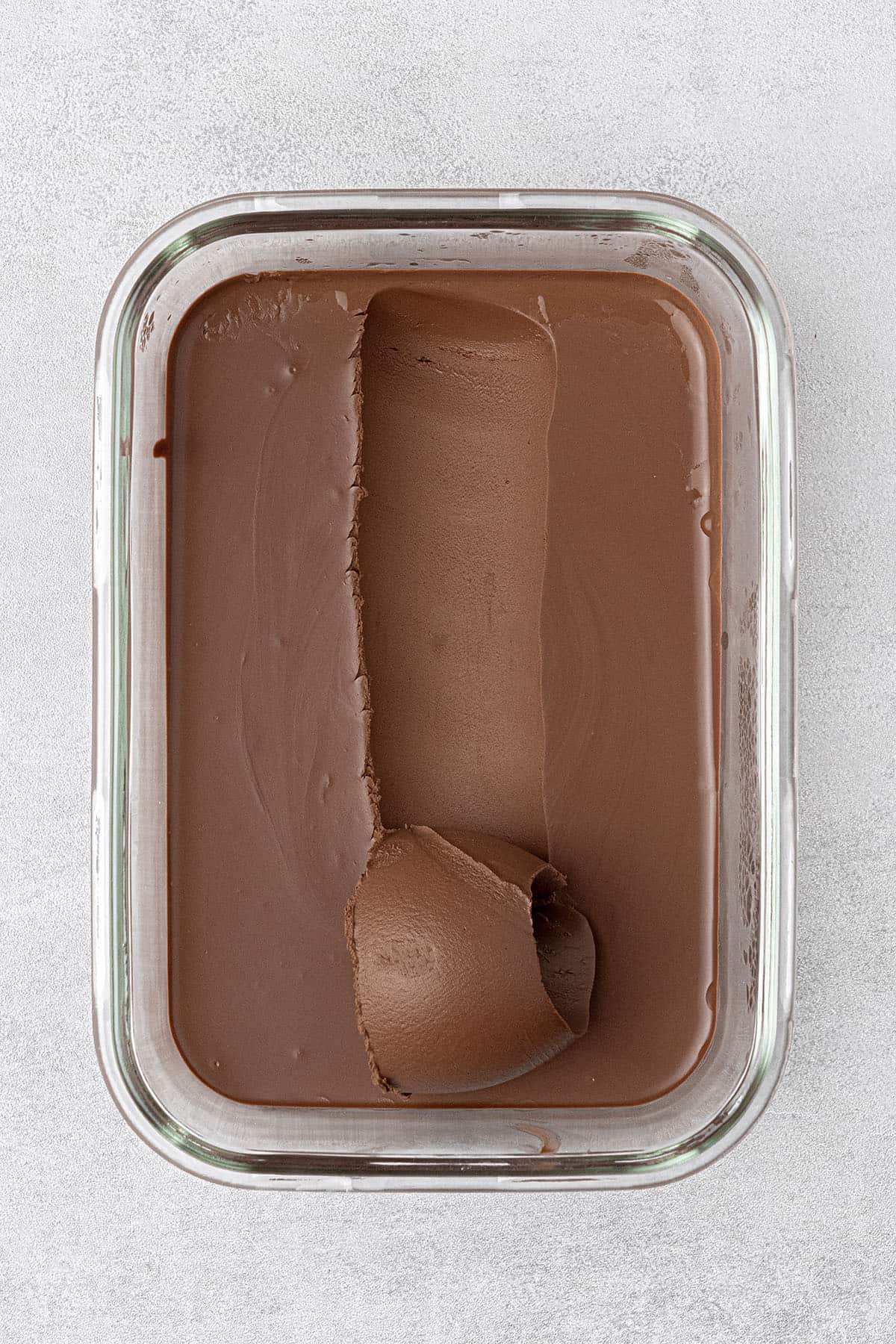
🌟 Why this is the best recipe
- It is rather easy – As fancy as it sounds, making Namelaka is extremely easy and quick! It comes together in 10 minutes using 4 ingredients simple ingredients
- It is super delicious – I never compromise on taste! The melt in your mouth texture with just the right sweetness make this cream absolutely irresistible! Having said that, your dessert will turn out as delicious as the chocolate you are using, so aim for high-quality ingredients eg. Valrhona or Callebaut.
- It is an honest, detailed tutorial – While this recipe might look long, all the information I have written here, every tip and trick will help you achieve the perfect results without any issues on the way. Remember, baking is science, and every little detail written here is to help YOU!
- It is super versatile - You can easily flavor the cream by infusing the milk the night before using it, eg. with cinnamon, orange zest, etc.
- No special equipment is needed – All you need is a saucepan and you are good to make this cream
📝 Ingredient notes
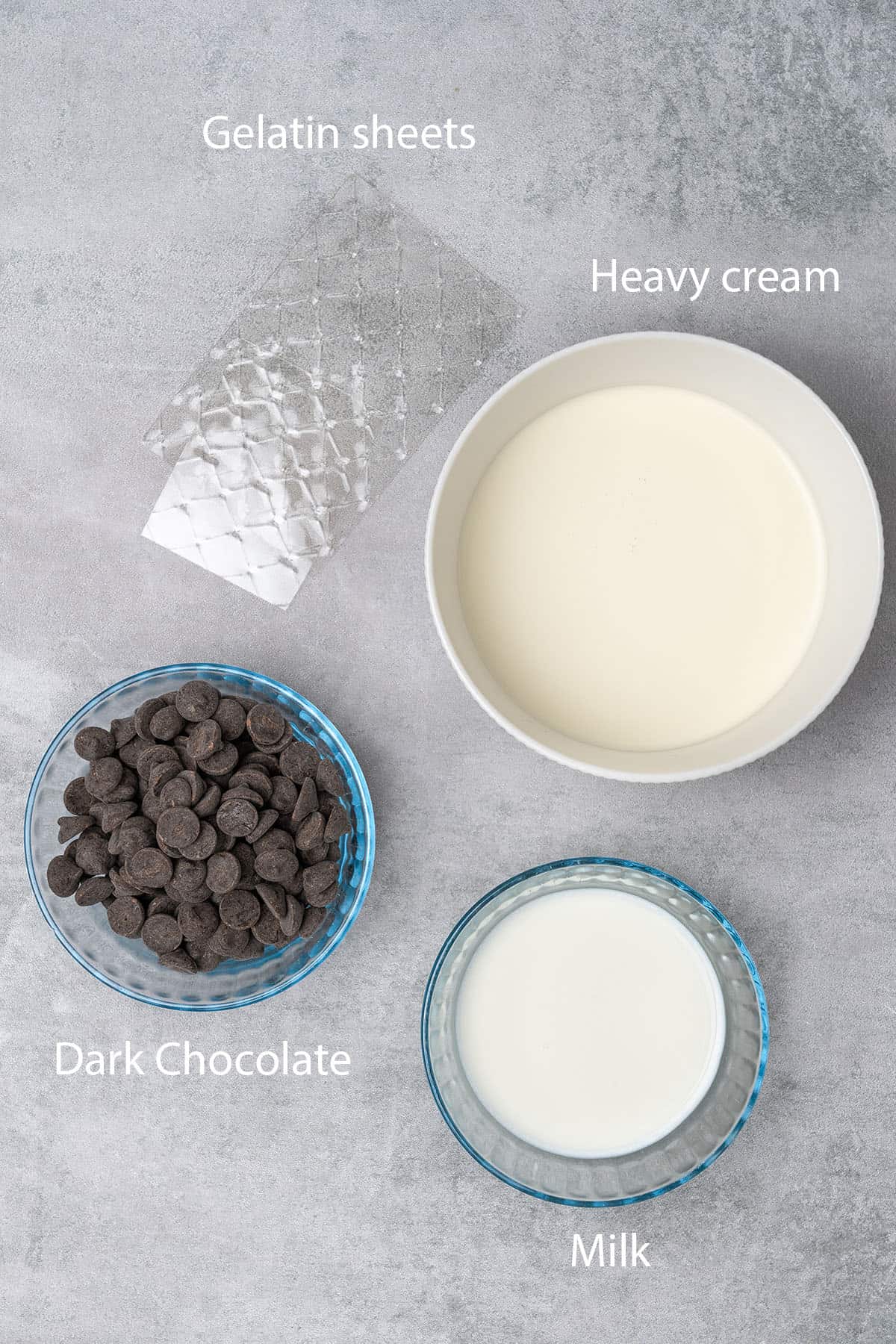
- Milk: I recommend high fat (3%) whole milk, please note that vegetable-based milk might not provide the same texture and thickness
- Chocolate: Just like making chocolate ganache, chocolate is the heart of making namelaka and your cream will be as delicious as the chocolate you are using. In this recipe, I am using Callebaut Dark Chocolate (callets) that has 54.5% cocoa butter content. Please see recipe FAQs below on how to adjust the recipe into milk or white chocolate namelaka (those have lower cocoa butter content therefore the recipe will need to be adjusted)
- Heavy whipping cream: Also known as heavy cream or whipped cream, has a fat content of 36%-40%, the one I use contains 36% fat. Avoid using lower fat content cream as the namelaka might not set the same way. Use it very cold and do not substitute with vegetable-based “whipped cream”
- Gelatin: It´s an odorless, tasteless, and colorless thickening agent, very often used in mousse cakes, and a must in namelaka. Powder or sheet versions are available, in my recipes I always use gold gelatin sheet (1,7 g gelatin/sheet), which I found easier to handle. Powder gelatin can be used 1:1 so when I state 1 gelatin sheet that means 1,7 g gelatin powder. Check my ultimate gelatin article for details on how to bloom gelatin and substitute options. If you prefer to use agar agar, check my agar agar article for further details.
🛒 You’ll find detailed measurements for all Ingredients in the printable version of the Recipe Card at the bottom of this post
👩🍳 How to make this recipe
1. Preparation process
Preparing the nemaleka could not be simpler, however, please respect the steps and the temperatures explained below, as well as the overnight resting time, and do not try to cut corners.
- Place finely chopped high-quality semi-sweet chocolate into a bowl, or use Callebaut Dark Chocolate (callets)
- Soak gelatin sheets in cold water while heating milk just until simmering. If it’s boiling, the milk is too hot and could burn the chocolate. If it is not warm enough, it won´t melt the chocolate properly
- Squeeze excess water from the gelatin sheets and stir them into the hot milk
- Pour warm milk over the chocolate. Let the two sit for a minute then stir and/or blend together
- Pour in cold cream and stir and/or blend together
- Place the cream into a shallow bowl or container and cover the entire surface with plastic wrap to avoid skin forming on top
- Refrigerate overnight (8 hours)
💡 Top Tip: 1 ¾ sheets of gelatin sheets equal to 3g of gelatin. You can easily substitute the gelatin sheets by using the same amount of gelatin powder. For agar-agar, follow conversions according to the package instructions. Check my ultimate gelatin article for more info on gelatin and substitute options
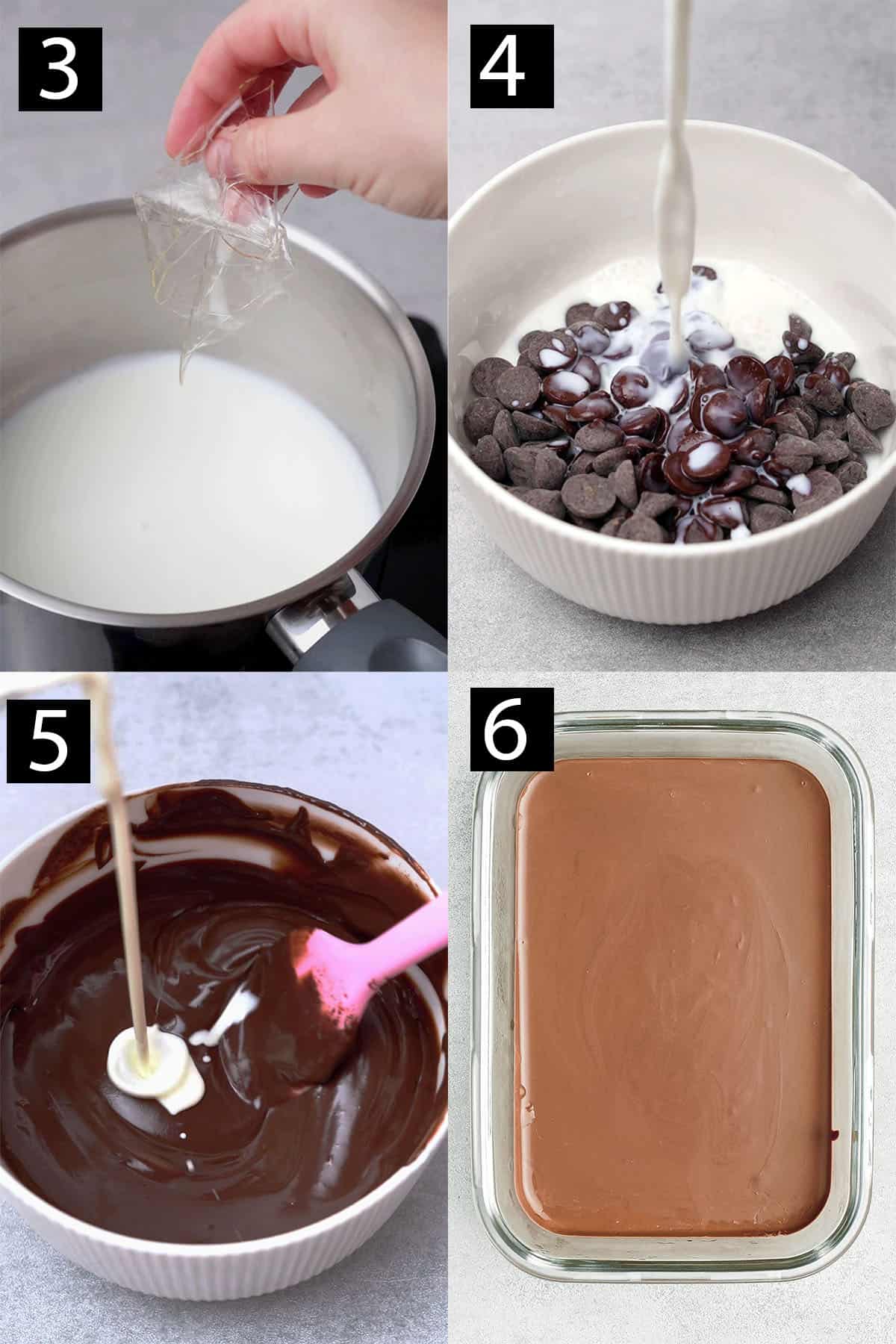
2. Flavor variations
Besides its amazing texture, one great benefit of namelaka is its versatility, by swapping the chocolate or flavoring the milk, you can literally make endless flavor variations.
If you want to use different chocolate, you will want to take into consideration the cocoa butter % and adjust this base recipe accordingly. I recommend using about 180g-200g of milk or white chocolate (instead of 140g of dark chocolate) depending on the cocoa butter % of your chocolate.
For flavoring namelaka, boil milk the night before and infuse the desired flavor into the milk overnight. Then, the next day run the milk through a sieve and start using it according to the recipe. With white chocolate, I recommend experimenting with and infusing the following flavors; cinnamon, coffee beans, ginger, star anise, citrus zest, tonka bean, lavender, vanilla bean, rose petals, earl grey tea leaf, etc. With dark chocolate, the options are slightly more limited due to its stronger base taste, but orange zest, coffee beans, ginger, cinnamon, and black pepper can be a good idea.
Please note that you will lose some volume of the milk during the overnight infusion, so the next day, when starting to make the namelaka, make sure you measure the milk again and fill it up to achieve the volume stated in the recipe. So eg. you heat up and infuse 100g of milk with coffee beans. The next day, after running it through a sieve, you measure the milk again and it might be only 85g. Then, fill it up with 15g of milk to achieve the initial 100g.
💡 Top Tip: Namelaka can be also flavored after the cooking process (before chilling) eg. with matcha or freeze dried raspberry powder. Make sure to blend these into the cream throughout
3. How to use
After namelaka sets in the fridge (for a minimum of 8 hours), give it a few whisk, move it into a piping bag fitted with your favorite nozzle tip and use the cream according to the recipe. It can be a wonderful cream to fill, frost, or decorate desserts eg. cakes or cupcakes.
Alternatively, with the help of an electric hand mixer, whip the cream for 1-2 minutes. Since the heavy cream is not boiled in this recipe (as opposed to ganache), it can actually be whipped up at later stage providing the most amazing fluffy texture.
💡 Top Tip: Namelaka can be also used as an individual layer in desserts, eg. you could make tiramisu with one layer of coffee-flavored namelaka between the mascarpone cream and ladyfingers
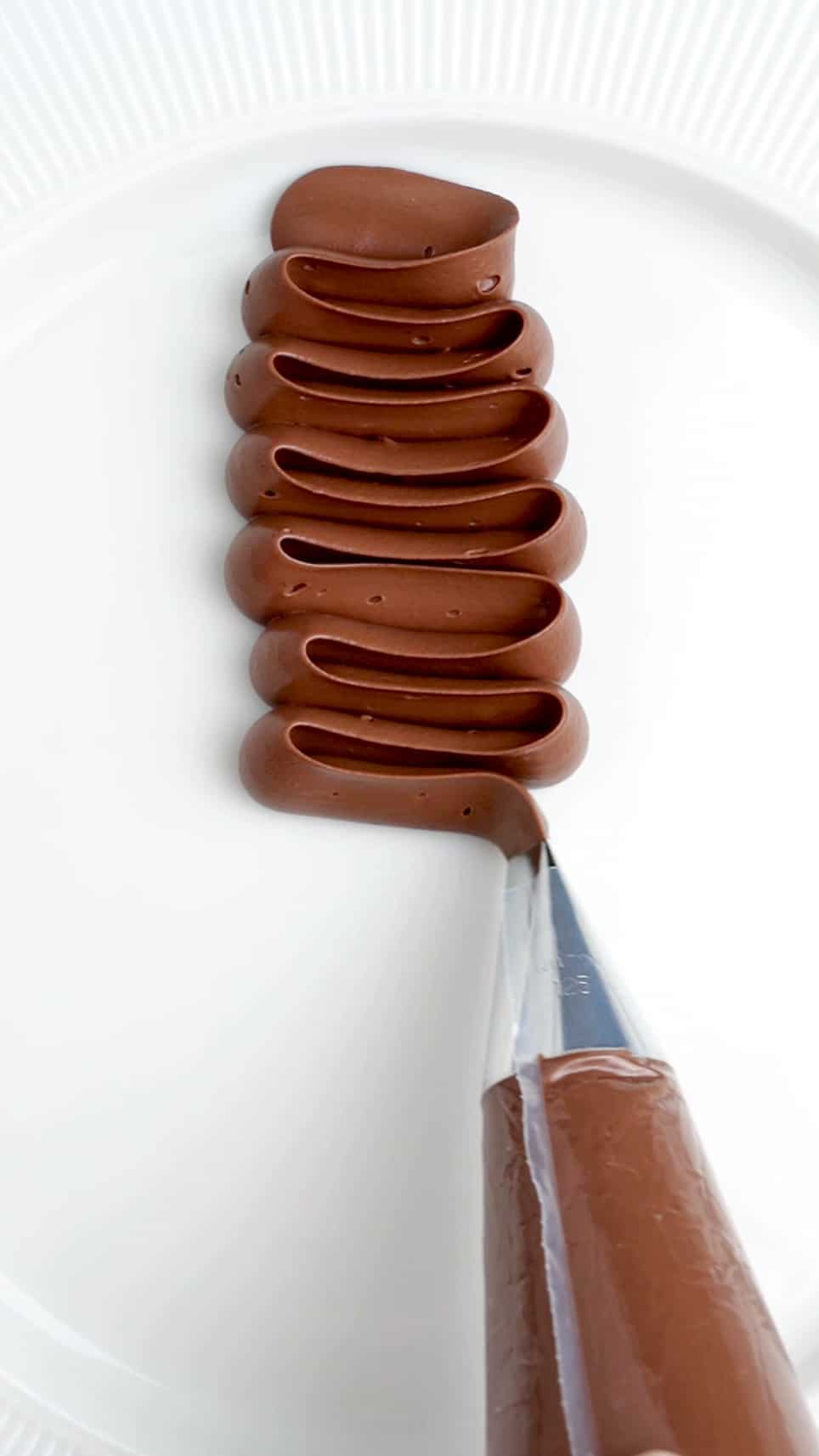
🎓 Expert tips
- Use high-quality chocolate as that will define the taste of your namelaka
- Heat milk until just simmering. If it’s boiling, the milk is too hot and could burn the chocolate. If it is not warm enough, it won´t melt the chocolate properly
- When incorporating the cold heavy cream, make sure that the milk-chocolate mixture is not warm, but around room temperature
- Chilling time is needed for the gelatin and chocolate to set. It cannot be skipped
❓ Recipe FAQs
Since dark chocolate contains more cocoa butter than milk or white chocolate, to achieve the same texture on your cream, you will need to use more white or milk chocolate. I recommend about 180g-200g (instead of 140g dark chocolate) depending on the cocoa butter % of your milk / white chocolate
Yes, you can, however, you will need to use another thickening agent eg. agar-agar. Substitute gelatin with agar agar according to the instructions on the package
The namelaka is quite runny straight after making, however, the gelatin and the chocolate itself will make it set in the fridge. If your cream has not set, maybe it needs more time in the fridge, or perhaps your measurement was off eg. you used less gelatin than stated in the recipe, or your chocolate has lower cocoa butter %, or perhaps the heavy cream has less than 36% fat content
Namelaka can be stored in the fridge for a few days. I suggest you cover it to make sure it does not absorb any smell from the fridge
Any leftover cream - if there is any - can be freezed in an air-tight container.
🍰 More frosting and filling recipes
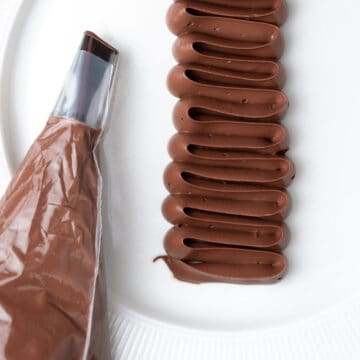
Chocolate Namelaka
Equipment
- Digital scale
Ingredients
- 140 g Callebaut Dark Chocolate (callets) good quality semi sweet chocolate
- 106 g Milk whole milk
- 1¾ Gelatine sheet equal to 3g gold gelatin
- 212 g Heavy cream 36% fat, use it cold
US customary cup measurement is an indicative figure only. Measure the ingredients with a digital scale by weight (gram). Baking is art but also science which requires precision and accuracy.
Instructions
- Place finely chopped high-quality semi-sweet chocolate into a bowl, or use Callebaut Dark Chocolate (callets)
- Soak gelatin sheets in cold water while heating milk just until simmering
- Squeeze excess water from the gelatin sheets and stir them into the hot milk. Pour warm milk over the chocolate
- Let the two sit for a minute then stir and/or blend together
- Pour in cold cream and stir and/or blend together
- Place the cream into a shallow bowl or container and cover the entire surface with plastic wrap to avoid skin forming on top. Refrigerate overnight (8 hours)
- The next day, gently whisk it or whip it for a 1-2 minute and use it according to the recipe
- Store refridgated for a few days
Notes
- Measure your ingredients with a Digital scale for accuracy
- Good quality chocolate (eg. Valrhona, Callebaut) will make the best namelaka
- 1 ¾ sheets of gelatin sheets equal to 3g of gelatin. You can easily substitute the gelatin sheets by using the same amount of gelatin powder. For agar-agar, follow conversions according to the package instructions
- Make sure you read my Expert tips section above to maximize your success. A short recipe alone is not able to cover all the necessary details, and science behind baking.
- While making the cream, follow the steps and temperatures stated in the recipe
- Make sure you do not attempt to use the cream before it sets, respect the 8 hours of chilling time
- To turn this dark chocolate namelaka, into milk or white chocolate namelaka, you will need to use more white or milk chocolate. I recommend about 180g-200g (instead of 140g dark chocolate) depending on the cocoa butter % of your milk / white chocolate




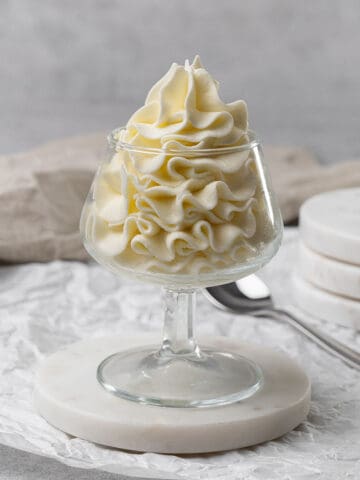




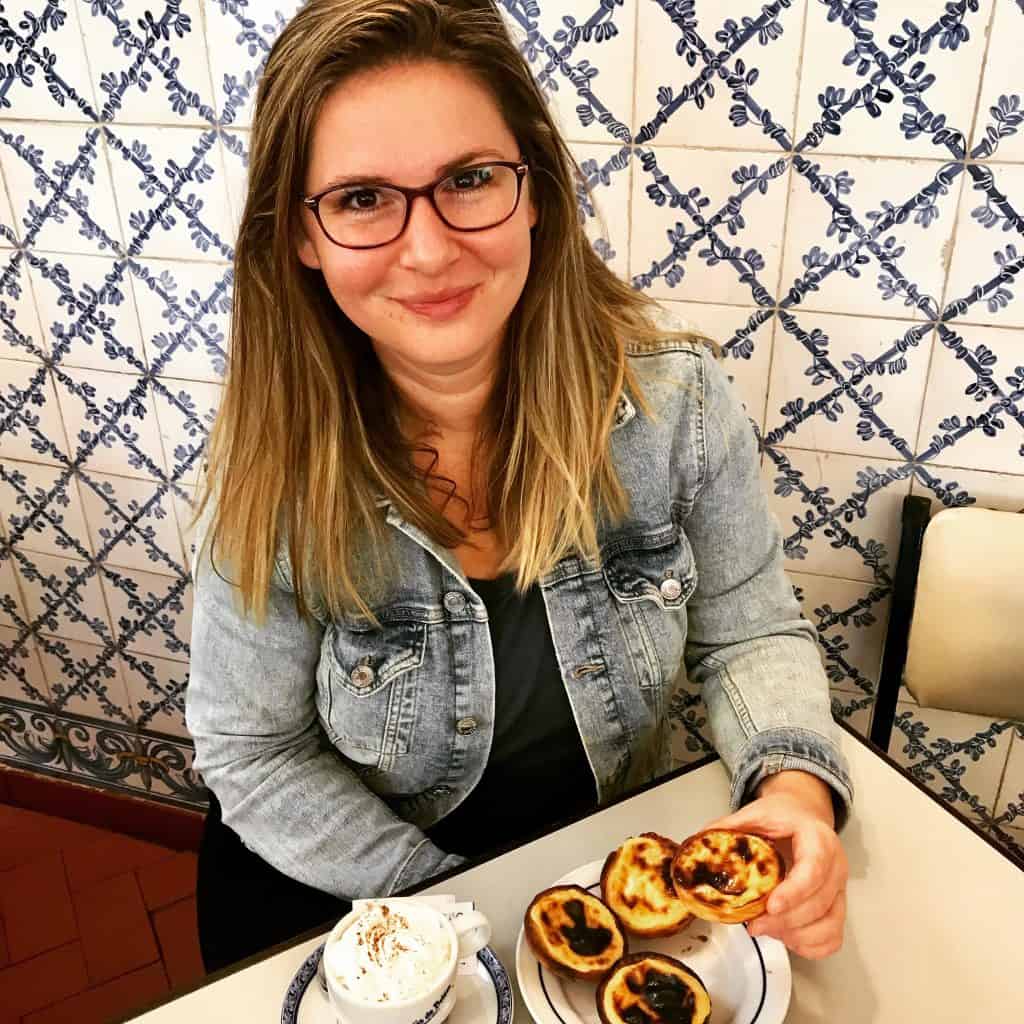
Gail Lopez-Henriquez
If I use a higher %age chocolate (such as Guittard 72%) should I use less chocolate?
Katalin Nagy
72% should be fine!
NA
Can I use half and half instead of milk? Thank you
Katalin Nagy
No, it has different properties eg. fat content.
Margaret
Loved the idea of this recipe, but unfortunately have made it twice now and both times it has a slightly ‘gritty’ texture. First time I used supermarket chocolate, but then ordered Callebaut in case the first chocolate was wasn’t good enough, but had the same result. What am I doing wrong?
Katalin Nagy
Perhaps overheating the cream and burning the chocolate? Pls send me an email and picture to spatuladesserts@gmail.com, I am happy to help.
JoAnne Sedler
Couldnt convert the grams to cups or whatever measure so average cook would not be able to use this recipe including me, so disappointing !! Not everybody is a gourmet cook or has a digital scale.
Katalin Nagy
You don´t have to be a gourmet to use a digital scale that costs 10USD. What is disappointing is people expecting consistent baking results by using cups which is not only highly inaccurate but also inconsistent worldwide. I am very happy to help you learn using digital scale, pls email me at spatuladesserts@gmail.com. It will change your baking game forever, I promise. Less dirty dishes is a plus:)
Sue
More and more recipes are calling for weight measurements. This gives more consistent results. With baking it's all about science. It's NOT cooking, it's baking where everything relies on the interaction of each element of the recipe. Buy a scale...I guarantee you'll never go back.
Joe
I have a couple more ideas for flavors to infuse into Namelaka. How about chilies or Aleppo pepper with dark and milk chocolate and curry with white chocolate.
Kata
They sound amazing, thanks 🙂
Margit
thx for sharing this recipe, it‘s so easy to prepare and tastes really delicious. Will add the cream to a black forest creme served in glasses
(dark chocolate brownie in the bottom, cherries, namelaka and whipped cream on top.
Raymond
Hi,
would like to ask is the namelaka cream hold up at room temperature?
Thanks in advance.
Kata
Yes the pictures were taken at room temperature however you cannot really leave it out for hours in the heat (that is pretty much the same with any other frosting).
Chantal
How long will things cream last in the fridge?
Kata
Few days should be fine
Gabrielle
Hello, will this go well with the Paris Brest?
Kata
Yes, why not? 🙂 Maybe have prepare some raspberry cloulis and fresh fruit with it so the overall bite will be lighter:)
Dan
I always wanted to try namelaka , and this recipe is amazing! It turned out perfect, thank you 🙂
Julia
Hi! I loved this recipe, and am really excited to try it I just am wondering, how much is the fat percentage in the heavy cream?
Balint Balazzs
It is 36% and in fact, quite important to use high fat cream and whole milk (3% fat) 🙂
Fatima
Hi
Thank you for sharing. Your recipes are such winners only I have a problem with the gelatine
Plz can u tell me the conversion of the gelatine in grams for fish gelatine .
Kata
If using any other thickening agent than gold gelatin sheet (that I recommend), pls check the package of your product and apply the conversation rate accordingly. Unfortunately, I am not able to advise on this individually as there are hundreds of products all around the world and each requires slightly different ratios.
Debora
Amei , super detalhado. Vou testar a receita. Fiquei em duvida qt a um item: Alternativamente, com a ajuda de uma batedeira elétrica, bata o creme de leite por 1-2 minutos. Como o creme de leite não é fervido nesta receita (ao contrário do ganache), ele pode ser batido em um estágio posterior, proporcionando a textura fofa mais incrível...
Neste caso ele entra em qual momento na receita, quando realiza a nameleka ou no oitoutro dia?
Grata